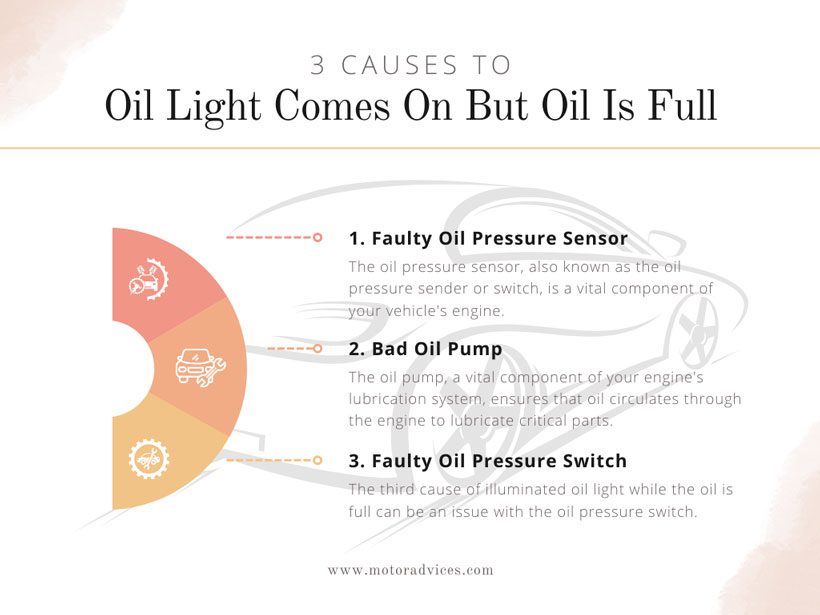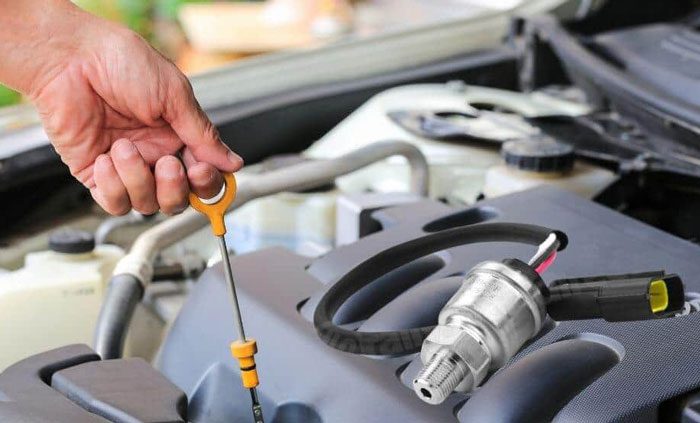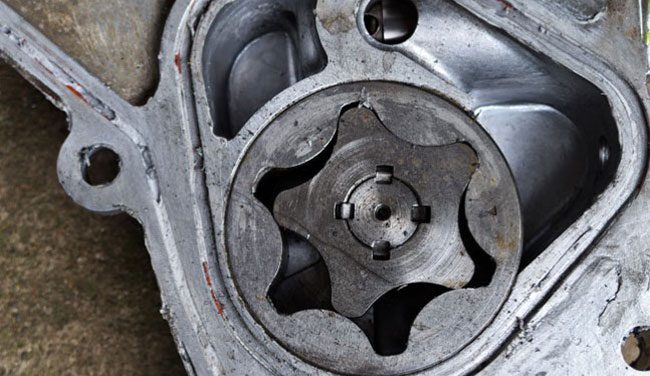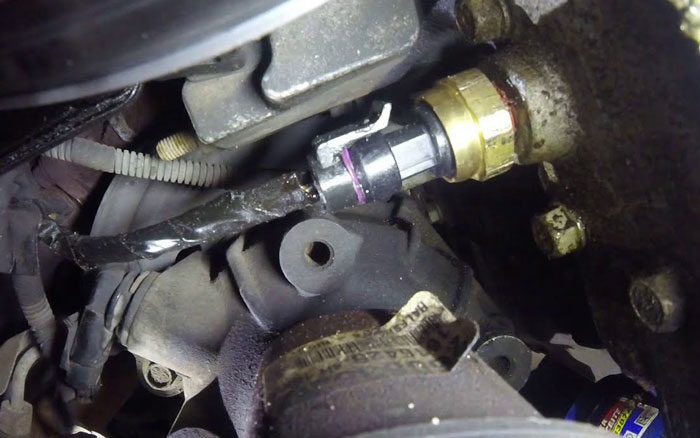Oil Light Comes On, But Oil Is Full: Causes and Fixes
When you’re driving, there’s nothing more unsettling than seeing your vehicle’s oil light illuminate on the dashboard. Especially when you’ve recently checked and confirmed that your oil level is perfectly fine.
So, why does the oil light come on, but the oil is full.? Well, it could be the faulty oil pressure sensor, the bad oil pump, or a bad oil pressure switch.
Whether you’re a car enthusiast or just seeking answers, you’re in for an informative ride. So, let’s unveil the reasons behind this puzzling scenario and ensure you hit the road worry-free.
3 Causes And Solutions to Oil Light Comes On, But Oil Is Full
Many reasons cause the oil light to come on, but the oil is full. This unexpected occurrence can leave you puzzled and worried about the health of your vehicle’s engine. However, there’s no need to panic just yet.
In this section, we have delved into the three primary culprits behind the “oil light coming on, but oil is full” issue, starting with the first suspect:

1. Faulty Oil Pressure Sensor
The oil pressure sensor, also known as the oil pressure sender or switch, is a vital component of your vehicle’s engine. Its primary function is to monitor the oil pressure within the engine. Then, it sends this information to the engine control unit (ECU) or oil pressure gauge on your dashboard.
This sensor typically uses a diaphragm, which reacts to changes in oil pressure. When the pressure drops below a certain threshold, it triggers the warning light on your dashboard.
However, if the oil pressure sensor is defective, it can send an erratic signal even when the oil is full. Therefore, the oil light will flicker on and off.

How To Test?
Testing the oil pressure sensor can be a relatively straightforward process. You’ll need an oil pressure gauge that can be connected to the sensor port.
Connect the gauge and compare the reading to the manufacturer’s specifications with the engine running at operating temperature.
If the gauge shows adequate oil pressure, it suggests the sensor is faulty, as the pressure is sufficient.
How To Fix It?
Replacing a faulty oil pressure sensor is a common and relatively simple task.
- Locate the sensor (often found near the oil filter or on the engine block).
- Disconnect the electrical connector.
- Use a suitable wrench to remove the sensor.
- After removing the old sensor, thread in the new one, tighten it to the recommended torque and reconnect the electrical connector.
- Be sure to use a sensor that matches your vehicle’s specifications.
For a visual guide on testing and replacing a faulty oil pressure sensor, you can watch this helpful YouTube video tutorial.
How Much Does It Cost?
The cost of a new oil pressure sensor can vary depending on your vehicle’s make and model. On average, you can expect to spend between $20 and $50 for the part.
If you’re comfortable with DIY car repairs, this is an affordable fix. However, if you prefer professional installation, labor costs at a mechanic’s shop could add another $50 to $100.
2. Bad Oil Pump
The oil pump, a vital component of your engine’s lubrication system, ensures that oil circulates through the engine to lubricate critical parts.
It consists of a series of gears or rotors that create suction, drawing oil from the oil pan and sending it through the engine. This continuous oil flow maintains the engine components’ smooth operation by reducing friction and dissipating heat.
A damaged oil pump fails to deliver enough oil volume to the engine. Therefore, despite the oil being full, your vehicle falsely detects it as low oil level. Consequently, the oil light comes on.

How To Test?
Testing your oil pump’s functionality is essential if you suspect it might be the cause of your oil light woes. Here are the steps to test it:
- Prepare Your Tools: You’ll need an oil pressure gauge and a wrench to remove the oil pressure-sending unit.
- Locate the Oil Pressure Sending Unit: This unit is usually screwed into the engine block or near the oil filter. Consult your vehicle’s manual for the precise location.
- Disconnect Electrical Connector: Safely disconnect the electrical connector from the oil pressure-sending unit.
- Connect the Gauge: Attach the oil pressure gauge to the port where the sending unit was removed.
- Start the Engine: Start your vehicle’s engine and let it idle.
- Observe the Gauge: Now, take a reading from the meter of the gauze while the oil is still cold.
Let the engine run for an additional 10-15 minutes and warm up the oil. Then, measure PSI again.
If the PSI difference is more than 10 between cold oil and warm oil, it indicates an issue in the oil pump.
How To Fix It?
If your oil pump is found to be the culprit, replacing it is often the best course of action. Here’s how to do it:
- Drain the Oil: Begin by draining the engine oil to avoid spillage during the pump replacement.
- Locate the Oil Pump: The oil pump is typically inside the engine, behind the oil pan.
- Remove the Oil Pan: Carefully remove the oil pan to access the pump. This might involve removing bolts or other components securing the pan.
- Replace the Pump: Unscrew and remove the old oil pump, then replace it with a new one that matches your vehicle’s specifications.
- Reassemble: Reattach the oil pan, ensuring a proper seal. Refill the engine with fresh oil.
- Test: Start the engine and recheck the oil pressure to ensure it’s within the recommended range.

How Much Does It Cost?
On average, you can expect to spend anywhere from $100 to $500 for the oil pump.
Labor costs can add another $200 to $500 if you have a mechanic perform the replacement. Overall, the total cost could range from $300 to $1,000 or more, depending on the specifics of your situation.
3. Faulty Oil Pressure Switch
The third cause of illuminated oil light while the oil is full can be an issue with the oil pressure switch. This is a small device that shuts off or on a circuit based on the oil pressure of the engine.
Normally, when oil is reduced to a certain level, this switch receives a signal from the power control module (PCM). It then connects the circuit so the light goes on.
However, if it’s malfunctioning, it can open the circuit despite the PCM not sending a signal as the oil remains full.

How To Test?
To detect a fault in the oil pressure switch, you need to measure the resistance of the switch. Here are the steps:
- Find the switch in the engine. It’s a small metal device with a wire connector. Head to the manual to pinpoint the location.
- Now, lose the connector using a wrench. Then, disconnect the wire connector from the switch.
- To measure the resistance, pick a multimeter and set it to the ohm settings.
- Touch the probes of the multimeter to the metal pins.
- On the multimeter display, read the resistance value.
- Depending on whether the switch is open or closed, the resistance value should be either 0 or infinite. When there is low oil pressure, the switch is open, and when there is high oil pressure, it is closed.
- Your car’s manual contains information on the standard oil pressure for your engine.
- Compare the resistance value to your engine’s typical value.
The interpretation of the result is the following:
- If the resistance value aligns with the standard value, the oil pressure switch functions appropriately.
- However, if the resistance value deviates from the standard value, the oil pressure switch is malfunctioning and requires replacement.
How To Fix It?
Follow these steps to replace the faulty oil pressure switch:
- First, disconnect the wire connector.
- Then, pull out the old switch from the engine block using a wrench. If the wrench can’t do it, use a special switch socket to fit the switch.
- Now, install the new switch on the engine block.
- Ensure the threads are clean and apply some thread sealant or tape to prevent oil leakage.
- Screw the new switch in with your hand and then tighten it with a wrench.
- Reconnect the wire connector to the new switch.
- Start the engine and you’ll no longer see the illuminated oil light.
Watch this video
How Much Does It Cost?
This switch is inexpensive. You can expect a premium of one below a hundred dollars starting from $20.
FAQs
We’ve almost finished today’s topic. Before we leave, let’s answer some common queries about oil lights.
A: Check the oil level by following steps:
- Open the hood and pull out the dipstick.
- Clean it and insert it back into the tube.
- Now, notice the end of the dipstick where the oil level is.
- The dipstick has minimum and maximum markings. Adhering to these, you can determine whether the oil is full or not.
A: No, you shouldn’t. Because the oil light warning indicates a fault in the engine lubrication system. It may be low oil, a faulty oil pump, etc. Whatever the cause, it can harm your engine such as overheating, seizing, or knocking.
Final Words
Dealing with the oil light comes on but oil is full issue can be confusing. Our journey uncovered the leading causes: a Faulty Oil Pressure Sensor, a Bad Oil Pump, and Oil Leakage.
With this knowledge, you’re ready to diagnose and fix these problems. Remember, regular car check-ups and staying alert are your best friends for keeping your engine healthy. So, hit the road confidently, knowing you’ve got the tools to tackle this tricky situation.”

